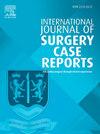Acute peritonitis caused by a giant appendicolith: A rare case report and a literature review
IF 0.6
Q4 SURGERY
引用次数: 0
Abstract
Introduction
Giant appendicoliths, which are calcified deposits larger than 2 cm found in the appendix, are uncommon and often linked to appendicitis, as well as complications like perforation or abscess formation. The occurrence of a giant appendicolith leading to peritonitis without accompanying appendicitis is rare, presenting a distinct diagnostic and therapeutic challenge.
Presentation of case
A 77-year-old male with beta-thalassemia minor came in with acute pain in the right lower quadrant, along with nausea and vomiting. Upon examination, he showed signs of peritoneal irritation, including rebound tenderness and guarding. Laboratory tests indicated mild leukopenia and normal inflammatory markers. Imaging studies identified a 5 cm appendicolith and localized free fluid suggestive of perforation, along with signs of superimposed peritonitis. Surgical intervention revealed a distended appendix containing the giant appendicolith and an ileocecal perforation, but histopathological analysis showed no evidence of acute appendicitis. The patient underwent an appendectomy and repair of the perforation, resulting in an uneventful recovery.
Discussion
Giant appendicoliths can lead to significant mechanical irritation and complications such as perforation, even in the absence of the typical inflammatory response associated with appendicitis. The diagnostic difficulty arises from the lack of fever and elevated inflammatory markers, which are usually present in cases of acute appendicitis.
Conclusion
Giant appendicoliths should be included in the differential diagnosis for acute abdominal pain, even when appendicitis is not evident. This case highlights the necessity of thorough approaches for accurate diagnosis and effective treatment.
求助全文
约1分钟内获得全文
求助全文
来源期刊
CiteScore
1.10
自引率
0.00%
发文量
1116
审稿时长
46 days

 求助内容:
求助内容: 应助结果提醒方式:
应助结果提醒方式:


